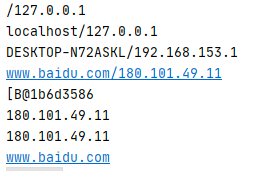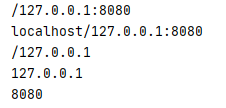JAVA--网络编程
1.网络编程
1.1 网络编程介绍
小结:
- 网络编程中有两个主要的问题
如何准确定位到网络上的一台或者多台主机
找到主机之后如何进行通信 - 网络编程中的要素
ip和端口号----通过ip类
网络通信协议----通过udp和tcp类 - 万物皆对象
1.2 IP
ip地址:InetAddress
1. 唯一定位一台网络上的计算机
2. 127.0.0.1 : 本机localhost
3. IP地址的分类
ipv4/ipv6
ipv4:127.0.0.1,4个字节组成,0-255
ipv6:128位,8个无符号整数,例如2001:0bb2:4aa1:1222:4342:5555:222a:333b
公网(互联网)-私网(局域网)
ABCD类地址
192.168.xx.xx专门给组织内部使用的
4.域名:记忆ip问题
ip:www.vip.com
InetAddress类
package netbiancheng;
import java.net.InetAddress;
import java.net.UnknownHostException;
public class TestInetAddress {
public static void main(String[] args) {
//try-catch快捷键,选中alt+ctrl+T
try {
//查询本机地址
InetAddress inetAddress = InetAddress.getByName("127.0.0.1");
System.out.println(inetAddress);
InetAddress inetAddress3 = InetAddress.getByName("localhost");
System.out.println(inetAddress3);
InetAddress inetAddress4 = InetAddress.getLocalHost();
System.out.println(inetAddress4);
//查询网站地址
InetAddress inetAddress2 = InetAddress.getByName("www.baidu.com");
System.out.println(inetAddress2);
//常用方法
//System.out.println(inetAddress2.getAddress());
System.out.println(inetAddress2.getCanonicalHostName()); //规范的名字
System.out.println(inetAddress2.getHostAddress()); //ip地址
System.out.println(inetAddress2.getHostName()); //域名或者自己电脑的名字
} catch (UnknownHostException e) {
e.printStackTrace();
}
}
}
1.3 端口
端口表示计算机上一个程序的进程
1.不同的进程有不同的端口号,用来区分软件,一般被规定端口为0-65535。还分为TCP端口和UDP端口,即总端口为65535*2。单个协议下,端口号不能冲突。
2.端口分类
公有端口0-1023
HTTP:80
HTTPS:443
FTP:21
SSH:22
Telent:23
程序注册端口:1024-49151,分配用户或者程序
Tomcat:8080
MySQL:3306
Oracle:1521
动态、私有:49152-65535
netstat -ano //查看所有的端口
netstat -ano|findstr "5900" //查看指定的端口
tasklist|findstr “8696” //查看指定端口的进程
端口InetSocketAddress类
package netbiancheng;
import java.net.InetSocketAddress;
public class TestInetSocketAddress {
public static void main(String[] args) {
InetSocketAddress inetSocketAddress = new InetSocketAddress("127.0.0.1",8080);
System.out.println(inetSocketAddress);
InetSocketAddress inetSocketAddress2 = new InetSocketAddress("localhost",8080);
System.out.println(inetSocketAddress2);
System.out.println(inetSocketAddress.getAddress());
System.out.println(inetSocketAddress.getHostName());
System.out.println(inetSocketAddress.getPort()); //获取端口号
}
}
1.4 通信协议
协议:约定,就好比我们现在说的普通话
网络通信协议: 速率,传输码率,代码结构,传输控制…
问题: 非常的复杂
大事化小:分层
TCP/IP协议簇:实际上是一组协议
重要的是:TCP:用户传输协议,UDP:用户数据报协议
出名的协议是TCP:用户传输协议,IP:网络互连协议
TCP,UDP对比
TCP:打电话
1.连接,稳定
2.三次握手,四次挥手
最少需要三次,保证稳定连接
A:你瞅啥?
B:瞅你咋地
A:干一场
最少需要四次,保证断开
A:我要走了
B:你真的要走了吗
B:你真的真的要走了吗
A:我真的要走了
3.客户端和服务端是分清界限的
4.传输完成,释放连接,效率低
UDP:发短信
1.不连接,不稳定
2.客户端和服务端没有明确的界限
3.不管有没有准备好,都可以发给你
4.导弹
5.DDOS(洪水攻击,饱和攻击)
1.5 TCP
客户端
1.连接服务器,通过Socket
2.发送消息
package TCP;
import java.io.IOException;
import java.io.OutputStream;
import java.net.InetAddress;
import java.net.Socket;
import java.net.UnknownHostException;
//客户端
public class TcpClientDemo01 {
public static void main(String[] args) {
Socket socket = null;
OutputStream outputStream = null;
try {
//1.要知道服务器的地址,端口
InetAddress ServerIP = InetAddress.getByName("127.0.0.1");
int port = 9999;
//2. 创建一个socket连接
socket = new Socket(ServerIP, port);
//3. 发送消息IO流
outputStream = socket.getOutputStream();
outputStream.write("hello".getBytes());
} catch (Exception e) {
e.printStackTrace();
}finally {
if(outputStream!=null){
try {
outputStream.close();
} catch (IOException e) {
e.printStackTrace();
}
}
if(socket!=null){
try {
socket.close();
} catch (IOException e) {
e.printStackTrace();
}
}
}
}
}
服务器
1.建立服务的端口,通过ServerSocket
2.等待用户的连接,通过accept
3.接收用户的消息
package TCP;
import java.io.ByteArrayOutputStream;
import java.io.IOException;
import java.io.InputStream;
import java.net.ServerSocket;
import java.net.Socket;
//服务端
public class TcpServerDemo01 {
public static void main(String[] args){
Socket accept = null;
InputStream inputStream = null;
ByteArrayOutputStream byteArrayOutputStream = null;
try {
//1.得先有一个地址
ServerSocket serverSocket = new ServerSocket(9999);
//2.等待客户端连接过来
accept = serverSocket.accept();
//3.读取客户端的消息
inputStream = accept.getInputStream();
//管道流
byteArrayOutputStream = new ByteArrayOutputStream();
byte[] buffer = new byte[1024];
int length;
if((length=inputStream.read(buffer))!=-1){
byteArrayOutputStream.write(buffer,0,length);
}
System.out.println(byteArrayOutputStream.toString());
} catch (IOException e) {
e.printStackTrace();
}finally {
if(byteArrayOutputStream!=null){
try {
byteArrayOutputStream.close();
} catch (IOException e) {
e.printStackTrace();
}
}
if(inputStream!=null){
try {
inputStream.close();
} catch (IOException e) {
e.printStackTrace();
}
}
if(accept!=null){
try {
accept.close();
} catch (IOException e) {
e.printStackTrace();
}
}
}
}
}
文件上传
客户端
package TCP;
import java.io.*;
import java.net.InetAddress;
import java.net.Socket;
import java.net.UnknownHostException;
public class TcpClientDemo02 {
public static void main(String[] args) throws Exception {
//1.读取服务端ip和端口
InetAddress inetAddress = InetAddress.getByName("127.0.0.1");
int port = 9000;
Socket socket = new Socket(inetAddress, port);
//2.输出信息
OutputStream outputStream = socket.getOutputStream();
//3.读取文件
FileInputStream fileInputStream = new FileInputStream(new File("1.jpg"));
//4.将读取的文件写入输出流
byte[] buffer = new byte[1024];
int length;
if((length=fileInputStream.read(buffer))!=-1){
outputStream.write(buffer,0,length);
}
//通知服务器,已经传输完毕
socket.shutdownOutput();
//接收服务器发来的结束信息
InputStream inputStream = socket.getInputStream();
//管道流,夹在客户端和服务器端输入和输出中间
ByteArrayOutputStream byteArrayOutputStream = new ByteArrayOutputStream();
byte[] buffer2 = new byte[1024];
int length2;
if((length2=inputStream.read(buffer2))!=-1){
byteArrayOutputStream.write(buffer2,0,length2);
}
System.out.println(byteArrayOutputStream.toString());
//5.关闭资源
byteArrayOutputStream.close();
inputStream.close();
fileInputStream.close();
outputStream.close();
socket.close();
}
}
服务器端
package TCP;
import java.io.FileOutputStream;
import java.io.IOException;
import java.io.InputStream;
import java.io.OutputStream;
import java.net.ServerSocket;
import java.net.Socket;
public class TcpServerDemo02 {
public static void main(String[] args) throws Exception {
//1.创建服务
ServerSocket serversocket = new ServerSocket(9000);
//2.监听客户端的连接
Socket socket = serversocket.accept();
//3.获取输入流
InputStream inputStream = socket.getInputStream();
//4.将获得文件输出
FileOutputStream fileOutputStream = new FileOutputStream("1.jpg");
byte[] buffer = new byte[1024];
int length;
if((length=inputStream.read(buffer))!=-1){
fileOutputStream.write(buffer,0,length);
}
//通知客户端,服务器端已经接收完毕
OutputStream outputStream = socket.getOutputStream();
outputStream.write("接收完毕".getBytes());
//5.关闭资源
outputStream.close();
fileOutputStream.close();
inputStream.close();
socket.close();
}
}
Tomcat
客户端
自定义C
浏览器B
服务端
自定义S
Tomcat服务器S:java后台开发
C/S即客户端/服务端,一般是在企业内部,无需网络也可传输
B/S即浏览器/服务器,用的更多
1.6 UDP
发短信:不用连接,需要知道对方的地址
发送端:
package UDP;
import java.net.*;
//不需要连接服务器
//UDP是以发送包的形式传输数据
public class UdpClientDemo01 {
public static void main(String[] args) throws Exception {
//1.建立一个Socket
DatagramSocket socket = new DatagramSocket();
//2.建立一个包
String msg = "hello";
InetAddress localhost = InetAddress.getByName("localhost");
int port = 9090;
DatagramPacket packet = new DatagramPacket(msg.getBytes(),0,msg.getBytes().length,localhost,port);
//3.发送包
socket.send(packet);
//4.关闭流
socket.close();
}
}
接收端:
package UDP;
import java.net.DatagramPacket;
import java.net.DatagramSocket;
import java.net.SocketException;
//等待客户端的连接
public class UdpServerDemo01 {
public static void main(String[] args) throws Exception {
//开放端口
DatagramSocket socket = new DatagramSocket(9090);
//接收数据包
byte[] buffer = new byte[1024];
DatagramPacket packet = new DatagramPacket(buffer, 0, buffer.length);
socket.receive(packet); //阻塞接收
System.out.println(packet.getAddress().getHostAddress());
System.out.println(new String(packet.getData()));
//关闭流
socket.close();
}
}
循环发送消息
package Chet;
import java.io.BufferedReader;
import java.io.InputStreamReader;
import java.net.*;
public class UdpSenderDemo01 {
public static void main(String[] args) throws Exception {
DatagramSocket socket = new DatagramSocket(9999);
//终端输入发送的信息
BufferedReader reader = new BufferedReader(new InputStreamReader(System.in));
while (true){
//读取信息
String msg = reader.readLine();
//将信息转为字节形式
byte[] bytes = msg.getBytes();
//将整个字节都放入数据包中进行传输
DatagramPacket packet = new DatagramPacket(bytes, 0, bytes.length, new InetSocketAddress("localhost", 6666));
socket.send(packet);
if (msg.equals("bye")){
break;
}
}
socket.close();
}
}
循环接收消息
package Chet;
import java.io.BufferedReader;
import java.io.InputStream;
import java.io.InputStreamReader;
import java.net.DatagramPacket;
import java.net.DatagramSocket;
import java.net.InetSocketAddress;
import java.net.SocketException;
public class UdpReceiveDemo01 {
public static void main(String[] args) throws Exception {
DatagramSocket socket = new DatagramSocket(6666);
while (true){
//利用缓冲区接收包裹
byte[] buffer = new byte[1024];
DatagramPacket packet1 = new DatagramPacket(buffer,0,buffer.length);
socket.receive(packet1);//阻塞式接收包裹
//打印出接受到的信息
String s = new String(packet1.getData());
System.out.println(s);
if(s.equals("bye")){
break;
}
}
socket.close();
}
}
在线咨询,两个人都可以是发送方,也可以是接收方
发送方
package Chet;
import java.io.BufferedReader;
import java.io.IOException;
import java.io.InputStreamReader;
import java.net.*;
public class TalkSend implements Runnable{
//1.建立一个Socket
DatagramSocket socket = null;
BufferedReader reader = null;
private int fromIP;
private String toIP;
private int toPort;
public TalkSend(int fromIP, String toIP, int toPort) {
this.fromIP = fromIP;
this.toIP = toIP;
this.toPort = toPort;
try {
socket = new DatagramSocket(fromIP);
reader = new BufferedReader(new InputStreamReader(System.in));
} catch (SocketException e) {
e.printStackTrace();
}
}
@Override
public void run() {
while (true){
//读取信息
String msg = null;
try {
msg = reader.readLine();
} catch (IOException e) {
e.printStackTrace();
}
//将信息转为字节形式
byte[] bytes = msg.getBytes();
//将整个字节都放入数据包中进行传输
DatagramPacket packet = new DatagramPacket(bytes, 0, bytes.length, new InetSocketAddress(toIP,toPort));
try {
socket.send(packet);
} catch (IOException e) {
e.printStackTrace();
}
if (msg.equals("bye")){
break;
}
}
}
}
接收方
package Chet;
import java.io.IOException;
import java.net.DatagramPacket;
import java.net.DatagramSocket;
import java.net.SocketException;
public class TalkReceive implements Runnable{
DatagramSocket socket = null;
private int port;
private String msgFrom;
public TalkReceive(int port,String msgFrom) {
this.port = port;
this.msgFrom = msgFrom;
try {
socket = new DatagramSocket(port);
} catch (SocketException e) {
e.printStackTrace();
}
}
@Override
public void run() {
while (true){
//利用缓冲区接收包裹
byte[] buffer = new byte[1024];
DatagramPacket packet1 = new DatagramPacket(buffer,0,buffer.length);
try {
socket.receive(packet1);//阻塞式接收包裹
} catch (IOException e) {
e.printStackTrace();
}
//打印出接受到的信息
String s = new String(packet1.getData());
System.out.println(msgFrom+":"+s);
if(s.equals("bye")){
break;
}
}
socket.close();
}
}
学生端
package Chet;
public class TalkStudent {
public static void main(String[] args) {
//开启两个线程
new Thread(new TalkSend(7777,"localhost",9999)).start();
new Thread(new TalkReceive(8888,"老师")).start();
}
}
教师端
package Chet;
public class TalkTeacher {
public static void main(String[] args) {
new Thread(new TalkSend(6666,"localhost",8888)).start();
new Thread(new TalkReceive(9999,"学生")).start();
}
}


